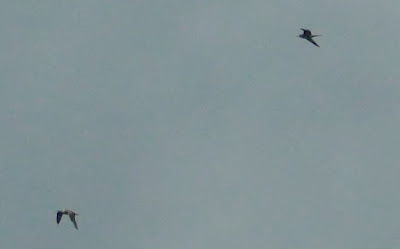Spring 2024.
Spring migration was quite hard work until a very exciting run of days in late May.
April saw a northward push of Iceland bound Pink-footed Geese over Ferry Hills with a peak of 3220 on 10th. FH also produced two quality migrant raptors on 6th with Osprey and Merlin north.
May started with a lovely male Ring Ouzel that pitched in briefly at Ferry Hills on 5th. Several Red-backed Shrikes arrived out on the E Neuk, part of a large arrival down the E coast of Britain and I was hopeful that one might make it up to my W Fife area with so many around, but it was not to be.
A cetacean stole the show in the first half of May with a Humpback Whale off Kinghorn on 12th. A Red Kite was seen drifting along the coast nearby the same day. Also in the Kinghorn area, a migrant Hooded Crow moved through on the 10th, a surprisingly rare bird on the E coast of Scotland. The views were good enough to rule out a hybrid.
Then the start of a memorable few days later in May. Actually, things started in a bit of a frustrating manner at Ferry Hills on 23rd with a distant large raptor crossing the Forth being mobbed by gulls which look suspiciously like a Black Kite. It would have only been the second for Fife and It was a little too distant to nail it. That same morning the mood was lifted when a Hobby went north, a long awaited Ferry Hills tick. Still a rare bird in Fife despite small numbers breeding to to north of us (I suspect they breed overlooked in Fife too). A Bonxie that flew up the Forth and then turned back east was also nice to see that morning, especially in light of the population being hit by avian influenza in 2023.
The the next day, 24th, things really stepped up a gear with a spur of the moment decision to visit Fife Ness and Kilminning. Conditions continued to look promising for migrants and I was thinking along the lines of a 'predictable scarcity' like Red-backed Shrike or Bluethroat, although in the case of Bluethroat there have been very few Fife records in recent years.
What I got was definitely not on the list of predictions... After checking the bushes at Lower Kilminning I decided the check the shore in the direction of Fife Ness as it looks great habitat for Bluethroat. I made my way slowly along the shore stopping regularly to scan ahead. Suddenly a large bird burst into the air off the beach ahead of me causing a few seconds confusion until my brain registered ‘of course it is.’ The combination of black and white wing markings and that distinctive profile, it could only be a Stone Curlew!
The bird gave me superb views as it flew towards me and then around me c30m away before heading towards the car park area. It was low down and seemed unlikely to have gone far and a weird field north of the green shed with short, brown vegetation (sprayed, slurry?) looked good. Sure enough, it was in there and despite a few jittery flights, the Stone Curlew settled down in the field for the rest of the day allowing many birders to get Stone Curlew on their Fife (and Scottish) list. This was only the 4th for Fife although, remarkably, the 3rd had only occurred last year. The 2023 bird at Anstruther had only been available to a few locals late in the day. The last Fife record before the 2023 bird was in 1965!
Other nice migrants about that day were Short-eared Owl, Spotted Flycatcher, Whinchat and on the drive home, a luminous singing male Yellow Wagtail at the traditional breeding site near Crail.
The run continued the following day, 25th, with an immature Spoonbill flying up the Forth at Ferry Hills. My third there but easily the closest views. A further bonus was a stunning summer Black-throated Diver flying W inland over the bridges, presumably on route to a breeding loch in the NW Highlands.
The spring began to slow down but in early June I went to see the smart male Lesser Scaup at Loch Gelly found by Jack Morris. A really smart example of this species which after a bit of a grilling could be seen to show all the features of LS, including the wing pattern in flight. A cautious approach is always needed with this species especially as a look alike hybrid Tufted x Pochard has been at the same site previously.
Very close views of an otter were a further highlight .























































